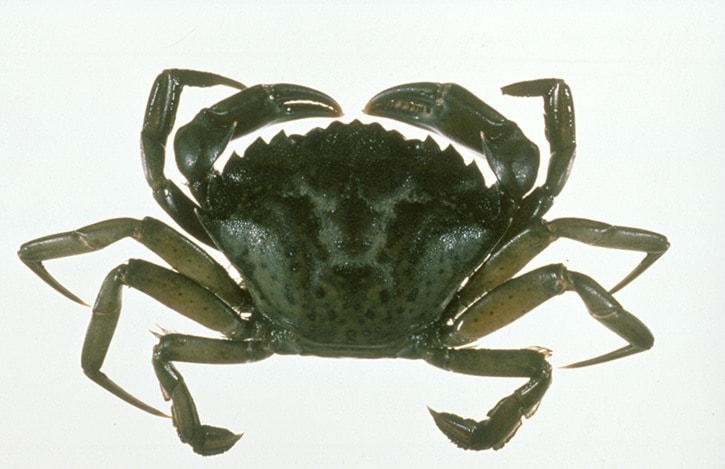The invasive European green crab is making a stand in the tiny lagoons and pocket estuaries of Sooke Basin, but so far the troublesome crustacean hasn’t found its way into the Juan de Fuca or Georgia straits.
That’s good news, say scientists.
The European green crab has been blamed for the collapse of the soft-shell clam industry in the Eastern U.S. and Canada; some are concerned it might likewise affect native and commercial species on the B.C. coast.
The crab was discovered in the Sooke Basin around 2013 and last year crab trap surveys revealed their populations had increased substantially, 30 to 50 in each trap.
But while the green crab seems to be flourishing on the West Coast of the Island, particularly around Barkley Sound, and heading north, the Sooke Basin remains an anomaly, said Thomas Therriault, a scientist with Fisheries and Oceans Canada at the Pacific Biological Station in Nanaimo.
The crabs enter the basin from the Whiffin Spit area and head east, but so far haven’t been found in either the Juan de Fuca or Georgia straits.
"They've not been found in the Salish Sea or the inland waters," Therriault said.
The European green crab is a voracious predator, using strong claws to crush the shells of mussels, oysters, clams, snails and juvenile crabs in its intertidal home.
There is a concern if the crabs get into either the Strait of Georgia or Strait of Juan de Fuca, they have the potential to destroy the lucrative aquaculture industry and create havoc on native species
They also spell trouble for eelgrass beds. En route to dinner, the green crab has a tendency to clip the eelgrass, which provides important nursery habitat for young salmon and many other species.
Scientists were alarmed last month when volunteers caught a green crab in Westcott Bay off San Juan Island, in Puget Sound.
It was one lone crab – not enough to fear the crustacean is conquering new water, said Therriault.
The Invasive Species Council of B.C. Is concerned at the impact the green crab will have on B. C.‘s native saltwater species, said Gail Wallin, executive director.
“The big message is we don’t want to distribute the green crabs through B.C.,” she said.
Green crabs have a long larval stage, when the crabs are microscopic and can travel long distances in ocean currents.
The fist-size crabs likely arrived from overseas in the bilge water of transatlantic ships. Experts say the crabs began taking a strong hold on Atlantic Canada’s coastline in the early 1990s, but may have been there since the 1800s.
The crabs first appeared in B.C. The waters near Berkeley Sound in the 1990s and have increased their population dramatically ever since.
Green crabs enter Sooke Basin likely through the help of humans – not ocean currents. The larvae hitch a ride on boat bottoms, fishing and diving gear, Therriault said.
If anyone spots a European green crab in the Strait of Georgia, the DFO and the Invasive Species Council of B.C. wants to know.
The best way to limit the spread of any invasive species is through reporting it, Wallin said.
The invasive species council encourages boaters and other recreation users to “clean, drain and dry” equipment.
“This way of you don’t know the difference between a green crab or a local crab, if your equipment is clean, your boat is clean, then you're not transporting them in any way,” Wallin said.
Adds Therriault: "Prevention is key. Once they're well-established then eradication becomes virtually impossible.”
